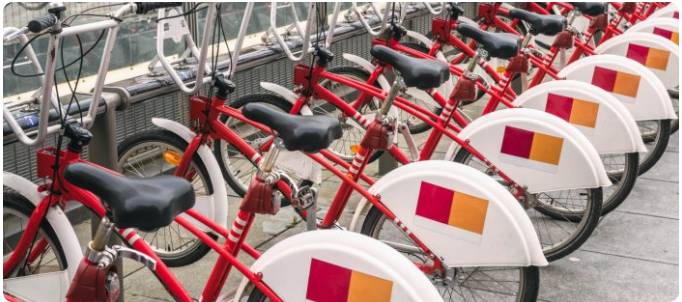Bicycle Sharing
Many cities around the world have adopted a bicycle sharing system. These systems allow people to cycle around the city, picking up a bicycle at one docking station and dropping it off at another. Not all docking stations experience the same use, however. Some stations might be popular starting places, leaving them empty at the end of the day, whereas others see many people arrive throughout the day and end up completely occupied. Understanding and predicting these patterns goes a long way in the planning of the redistribution of bicycles across docking stations that often happens at night. Yet the situation is even more complex, since people’s behaviour is influenced by many other factors, such as the weather, time of day and calendar. Forecasting the usage of bicycles also gives insight into the demand, allowing cities to anticipate higher demand by expanding the bicycle network, for example.
TIM’s Value
TIM can help in these scenarios, by taking into account many different variables, transforming and weighing them in order to produce accurate and understandable forecasts. Moreover, TIM allows for frequent model rebuilding, quickly adapting to meet challenges posed by sudden and unexpected changes in peoples behaviour. In case of any issues with data collection, TIM is also able to account for changes in data availability. Thanks to the explainability of the models, it is possible to develop a sense of understanding at what constitutes an accurate forecast, and what influence changes in predictors may have. This can serve as a start for answering questions like “How would the necessary redistribution change if it was colder than expected, tomorrow?”
Data
Apart from historical values of the amount of bicycles in use, this use case takes calendar data, weather data (temperature, windspeed, wind feel, humidity…) and the time of day as input. The generated models then produce forecasted values of the amount of bicycles in use, in the same granularity as the target input data.
Retail forecasting in COVID times
How to prepare your retail and online production, inventory and distribution for changing COVID-19 measures?
External factors can have a huge impact on your demand forecast for specific products in specific locations and channels. The constantly changing government guidance during the current COVID pandemic can also cause huge swings in demand, especially when wide reaching regulation – such as decisions to close restaurants or limit movement – can come and go within hours for entire towns, cities or countries. To help businesses dynamically allocate their scarce resources of staff and inventory, the use of TIM and real-time instant ML can create forecasts that are as dynamic as the events that influence them. This can enable fast business decisions to take advantage of opportunities and limit the costs of reacting to current events.
TIM’s Value
The TIM Engine is perfectly suited for this application, because of the speed, resilience and ease of deployment. Other forecasting methods, such as statistical forecasting, are far too slow to react to the modern business climate. Single variate models will miss on the complex interaction between seasonal changes, externally driven changes to demand and externally driven changes to mobility. The speed of forecasting is also incredibly important in determining what factors are causing permanent changes to demand and customer behavior and which changes will be temporary.
Using the TIM Engine, an analyst can quickly iterate on models using dozens or even hundreds of features to get predicted impacts on demand in near real-time. This is a must-have tool for anyone in an organization who is responsible for planning of inventory and/or staffing levels.
As an example, using the TIM product we can immediately predict the impact a new restriction in a specific town would have on online ordering in specific postcodes. This can be used to ensure the correct allocation of capital equipment (trucks), staffing (drivers) and product (warehouses) even in advance of the restriction being implemented. With the TIM Engine, this forecast can be available in minutes to respond to significant events that may be happening within only a few days. We can see that a new announcement of a restriction to restaurants causes an immediate surge in online grocery demand that lasts for several days before subsiding to pre-restriction levels. This analysis can be extended to review the impact on specific products at a SKU level – including the ability to run independent demand forecasts for individual SKUs at individual stores in seconds.
The Data
Demand Data has real-time access to external data of significance, such as weather data (forecast and history) for any geographic point, as well as real-time COVID cases, mobility and restrictions for each postcode in most major countries. This data can instantly be prepared as inputs to be combined with sales data for specific products, channels or store locations. We have templates available which can plug into sales data at a store level and create the base models instantly (including COVID, weather and human mobility). From there, your analysts can iterate using other data or assumptions they have and get feedback in seconds on which assumptions or data are good predictors and which ones are not.
Supply Chain Strategy Planning
Supply chains are under continuous pressure to maintain or improve their market position. The digital revolution lead to a surge of digital transformation initiatives as well as the emergence of new players who leverage new technological innovations to create new business models that trigger a tidal wave of disruptive contenders in an already highly competitive world. The speed of innovation leads to unprecedented dynamics; only the most agile supply chains are able to (re-)act and adapt. As a result of these new dynamics, traditional mid- to long-term strategies must be reviewed and adapted at a higher frequency. Evaluating the impact of market disruption, both from the demand and the supply side, requires advanced intelligence and analytics that can be set up and reconfigured rapidly to evaluate risk and discover opportunity. Traditional AI, and even automated machine learning approaches are expensive, slow and difficult to adapt to support the agility and velocity required to keep your business on track on the short and the long term. By combining business data and market prognosis scenarios with real time instant machine learning, organisations can create new, improve existing, and evaluate more what-if scenarios and simulations for strategic planning and business transformation. Some example of business strategy planning processes that benefit from InstantML forecasting are strategic budgeting exercises, business transformation and design initiatives, strategic product lifecycle planning and optimisation, and the product and product maintenance design process.
TIM’s Value
TIM (Real Time) Instant Machine Learning can be used to complement what-if and simulation scenarios for budget exercises, adapting maintenance for product support strategies, run forecasting and anomaly detection on digital twins in product design, do risk assessments in your business transformation process, etc. With TIM users can shorten the time to run and compare scenarios, include different future market projections as predictor candidates and easily interface with simulation tools.
Data
Typical inputs for this use case include historical demand, supply, production, prices, costs and strategic performance data, complemented with external data concerning weather, sales periods, global and regional disruptive events, sales campaigns, product introduction information, etc. In return, TIM’s output consists of middle to long term time series forecasts on budget, sales, etc.
Event Adjusted Budgeting
Anyone who has ever sat in an S&OP meeting or in budget review will have heard this before: “We would have hit our target if it wasn’t for the (rain, wind, snow, sun, cold, hot…).” Very rarely are these comments backed up with real facts – but you will get the occasional nod around the room. Ah yes… I do recall it rained on the second Saturday in July – that must be why we missed our target by 12%. Or the line in a seasonal review meeting that says, “Our winter boot sales are up this year over last year because of the early winter storm this year and the late Indian summer in 2017, remember???”
The problem with these statements is that though they may be true, mostly they are easy excuses that cover true problems within the business. Maybe there are supply issues, or merchandising issues or a general decline or growth of our brand. Instead of comparing actuals to budget, what if a third line could be added called “Event adjusted budget”. This way, managers, planners and executives can understand the impact that events, such as weather, may have played on our performance, but most importantly, this will help us to understand and think about what else might be happening in our business. Sounds interesting?
TIM’s Value
The good news is that with advances in Machine Learning and tools like the TIM engine, this is entirely possible to do. By comparing actual sales history at different levels of your organization and bringing in weather conditions on the day as features, a company can start to understand the importance of these features on driving actual sales. Using this data, we can start to see what categories are heavily impacted (ice cream, umbrellas, or the heating bill) and what locations get impacted (outdoor shopping malls, online sales, restaurant delivery). As the TIM engine begins to understand what event variables are driving volatility, we can create historical forecasts based on simulated conditions. (This is what we would have predicted this year based on the same conditions as last year as an example.) This means that the next time your sales rep argues they would have made their target if it wasn’t for the cold front, your business can support this with real evidence. Not only that, but you can start to use live weather forecasts or long-term weather trends to drive predictive interventions – like adding an extra employee at your beach café this weekend.
The Data
With cloud storage being so cheap, detailed datasets containing years of history for hundreds of thousands of weather data points are readily available. Not to mention other event data like football games, traffic patterns, holidays and much more. This data is relatively easy to find and there are many services that make this data available historically and as forward-looking projections. With this data and your historical sales and historical budgets, the TIM engine can train models to produce forecasts based on simulated conditions (or after removing them entirely).




